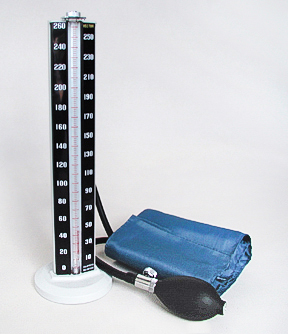Sphygmomanometer
(Redirected from Blood pressure monitors)
Sphygmomanometer[edit | edit source]
A sphygmomanometer is a medical device used to measure blood pressure. It consists of an inflatable cuff to restrict blood flow, and a manometer to measure the pressure. The device is used in conjunction with a method to determine the pressure at which blood flow begins and at which it is unimpeded.
History[edit | edit source]
The sphygmomanometer was invented in 1881 by Samuel Siegfried Karl Ritter von Basch. The device was further developed by Scipione Riva-Rocci in 1896, who introduced the use of an inflatable cuff. The modern sphygmomanometer was developed by Harvey Cushing, who introduced the use of the device in the United States.
Types[edit | edit source]
There are several types of sphygmomanometers:
Mercury Sphygmomanometer[edit | edit source]
The mercury sphygmomanometer is considered the gold standard for measuring blood pressure. It uses a column of mercury to measure pressure and is known for its accuracy.
Aneroid Sphygmomanometer[edit | edit source]
The aneroid sphygmomanometer uses a mechanical gauge with a dial to measure pressure. It is more portable than the mercury type but requires regular calibration.
Digital Sphygmomanometer[edit | edit source]
Digital sphygmomanometers are electronic devices that automatically measure blood pressure and display the results on a digital screen. They are easy to use and do not require a stethoscope.
Components[edit | edit source]
A typical sphygmomanometer consists of the following components:
- Cuff: A fabric band that wraps around the arm and inflates to restrict blood flow.
- Bulb: A rubber bulb used to inflate the cuff.
- Valve: A valve to release air from the cuff.
- Manometer: A device to measure the pressure in the cuff.
Measurement Technique[edit | edit source]
The measurement of blood pressure using a sphygmomanometer involves the following steps:
1. The cuff is placed around the upper arm and inflated to a pressure higher than the expected systolic pressure. 2. The pressure in the cuff is slowly released while listening with a stethoscope over the brachial artery. 3. The first sound heard (Korotkoff sound) indicates the systolic pressure. 4. The point at which the sound disappears indicates the diastolic pressure.
Clinical Use[edit | edit source]
Sphygmomanometers are used in various clinical settings to monitor blood pressure. They are essential tools in diagnosing and managing hypertension and other cardiovascular conditions.
Related Pages[edit | edit source]
Search WikiMD
Ad.Tired of being Overweight? Try W8MD's physician weight loss program.
Semaglutide (Ozempic / Wegovy and Tirzepatide (Mounjaro / Zepbound) available.
Advertise on WikiMD
|
WikiMD's Wellness Encyclopedia |
| Let Food Be Thy Medicine Medicine Thy Food - Hippocrates |
Translate this page: - East Asian
中文,
日本,
한국어,
South Asian
हिन्दी,
தமிழ்,
తెలుగు,
Urdu,
ಕನ್ನಡ,
Southeast Asian
Indonesian,
Vietnamese,
Thai,
မြန်မာဘာသာ,
বাংলা
European
español,
Deutsch,
français,
Greek,
português do Brasil,
polski,
română,
русский,
Nederlands,
norsk,
svenska,
suomi,
Italian
Middle Eastern & African
عربى,
Turkish,
Persian,
Hebrew,
Afrikaans,
isiZulu,
Kiswahili,
Other
Bulgarian,
Hungarian,
Czech,
Swedish,
മലയാളം,
मराठी,
ਪੰਜਾਬੀ,
ગુજરાતી,
Portuguese,
Ukrainian
Medical Disclaimer: WikiMD is not a substitute for professional medical advice. The information on WikiMD is provided as an information resource only, may be incorrect, outdated or misleading, and is not to be used or relied on for any diagnostic or treatment purposes. Please consult your health care provider before making any healthcare decisions or for guidance about a specific medical condition. WikiMD expressly disclaims responsibility, and shall have no liability, for any damages, loss, injury, or liability whatsoever suffered as a result of your reliance on the information contained in this site. By visiting this site you agree to the foregoing terms and conditions, which may from time to time be changed or supplemented by WikiMD. If you do not agree to the foregoing terms and conditions, you should not enter or use this site. See full disclaimer.
Credits:Most images are courtesy of Wikimedia commons, and templates, categories Wikipedia, licensed under CC BY SA or similar.
Contributors: Prab R. Tumpati, MD






